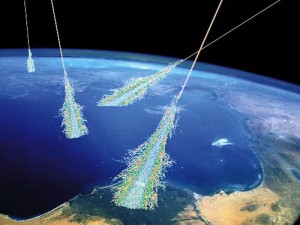Ars Technica reported last week on a paper by a group of researchers at the University of California which proposes using a large number of smartphones to monitor cosmic rays striking the earth’s atmosphere.

An illustration of showers of high-energy photons dispersed by cosmic rays striking the atmosphere. NASA, 2006, via wikimedia commons
Earth’s atmosphere protects us from cosmic rays. When cosmic rays hit the atmosphere, they create showers of high-energy photons, which is the only way of detecting them from the earth. They’re quite difficult to detect and study, however, since these photons are scattered over a large area.
A large number of detectors spread across a large area can be used to calculate more detailed information about a cosmic ray based on the time and location of detection, to calculate precisely where and when a cosmic ray struck the atmosphere. This study proposes to use idle smartphones as detectors.
The researchers found that the camera in a Samsung Galaxy S3, a popular smartphone, was able to distinguish high-energy photons. It’s fairly reasonable to assume that most other smartphone cameras also has this capability, as they use similar technology in their cameras.
The researchers developed an app which would allow smartphones to run a background process while the phone is charging that would capture video and send the relevant video along with time stamps and location information to a server, which would then process the data from many such smartphones for
This is a really interesting use of idle computing resources that’s not entirely dissimilar from other academic uses of idle computing resources, but it uses some of the capabilities that are ubiquitous on modern smartphones: GPS to detect location, and high-quality digital cameras.
If the researchers can get enough people to run the app, and secure funding for the computing power required to process the data, they’ll be able to gather a great deal of information about cosmic rays, including how frequently they strike, where and when, and with how much energy. While the project may face some challenges in adoption it is a clever and low-cost solution to a research problem.
